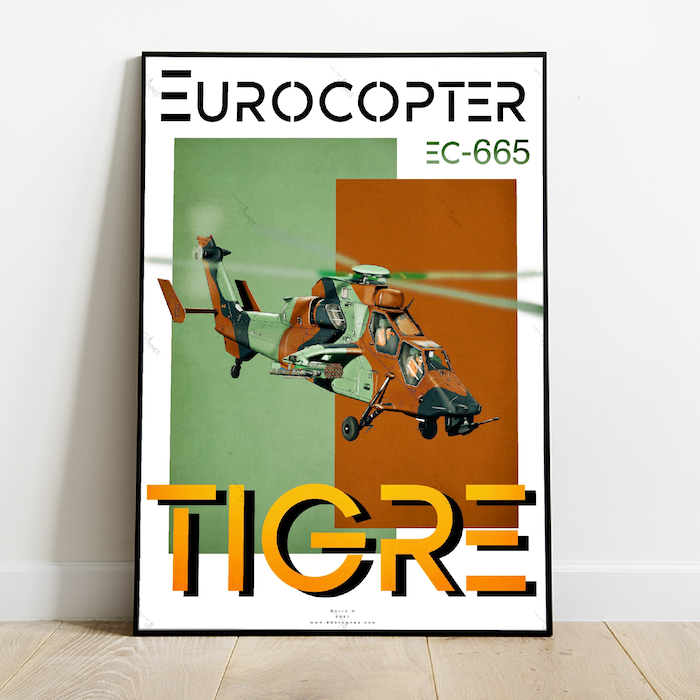




A digital drawing of the helicopter "Tigre" from Eurocopter company
The Tiger is a Franco-German attack helicopter developed and built by Airbus Helicopters, formerly Eurocopter.
After a long, unsuccessful gestation period and due to its high cost, the program was first canceled in 1986 and resumed the following year.
In November 1989, Eurocopter was awarded a contract to manufacture five prototypes, including a German anti-tank version and a French escort version. The first prototype flew on April 27, 1991.
As early as 2001, the Tiger program was placed under the responsibility of the joint organization for European armaments cooperation.
France and Germany, which started the program, joined Spain in 2004 and cooperation with Australia was formalized in 2009.
In 2007, the Tiger helicopter only began its operational experimentation in the light aviation of the French Army.
It weighs 6.6 tons at takeoff a weight 40% less than that of the AH-64 Apache which was used as a reference during the design of the Tiger. The 2 tons gained thanks to the composite structure of the Tiger on the metallic structure of the Apache allow it greater autonomy.
The excellent maneuverability resulting from its composite airframe, with acceleration limits of +4 g / -1 g, allows it to make a loop, to move nimbly through the various theaters of operation, in particular the mountains. The Tiger can also move in reverse at a speed of 70 km / h, in right lateral translation of 92 km / h, in left lateral translation of 129 km / h where the engine torque drives it.
Its lightness is the result of 80% composite materials, mainly Kevlar and carbon fiber in its structure. Radar, thermal and visual stealth has been worked on from the design stage, the device returns a minimal radar and infrared image, thanks among other things to the geometric design of the surfaces, the absorbent paints used and the thermal signature reducing system applied to the turbine exhaust.
The Tiger reaches a speed of 315 km / h (370 km / h nose down) in its HAD version. Its range is 800 km without an additional tank when flying at its economic speed of 222 km / h. With an additional tank, the Tiger can accompany an NH90 with its 8 commandos to its maximum radius of 320 km, to secure the landing zone, wait for the end of a commando operation such as village search or medical evacuation, for example, then cover the extraction area at the end of the operation. This ability of the Caiman / Tiger couple revolutionizes air combat maneuvers by taking the enemy out of speed.
It requires little maintenance, and can be carried out directly in the theater of operations with a team of 4 or 5 people. As on most combat helicopters, the pilot and the captain are placed one behind the other, which makes it possible to reduce the width of the aircraft and therefore its vulnerability to enemy frontal fire. The skipper is placed at the rear of the aircraft. Also, to improve its visibility, its seat is slightly raised compared to that of the pilot.
The pilots are equipped with a "TopOwl" helmet sight, which gives them a better view of the tactical environment. The helmet also presents an intensified night vision, directly projected onto the visor with a performance equal to night vision binoculars which are bulky and less intuitive to use for the pilot.
It is available in several versions, with different armament: UHT, HAP HAD, ARH.
Data sheet
| Dimensions | A2 (16,5 in × 23,4 in) |
|---|---|
| Paper | Matte 135 g/m² |
Specific References
No customer reviews for the moment.